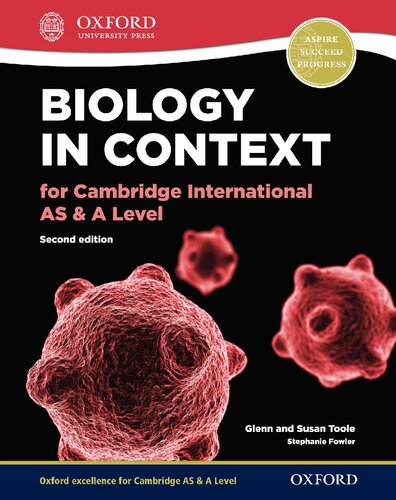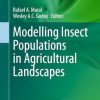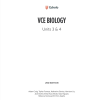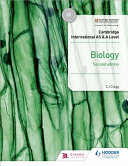Biology in Context for Cambridge International AS and A 2nd Edition by Glen Toole, Susan Toole ISBN 0198354819 9780198354819
$50.00 Original price was: $50.00.$25.00Current price is: $25.00.
Biology in Context for Cambridge International AS & A 2nd Edition by Glen Toole, Susan Toole – Ebook PDF Instant Download/Delivery: 0198354819, 9780198354819
Full download Biology in Context for Cambridge International AS & A 2nd Edition after payment
Product details:
ISBN 10: 0198354819
ISBN 13: 9780198354819
Author: Glen Toole, Susan Toole
Biology in Context for Cambridge International AS & A 2nd Edition: Mapped to the latest Cambridge A Level Biology syllabus (9700), this comprehensive resource supports students with its stretching, problem solving approach. It helps foster long-term performance in science, as well as building their confidence for the Cambridge examinations. The practical approach helps to make science meaningful, so it is ideal for students planning to study science at university. Includes support for the new Key Concepts – developing Cambridge students’ subject knowledge and encouraging them to make links between topics.
Biology in Context for Cambridge International AS & A 2nd Edition Table of contents:
1. Cell Structure
- 1.1 The Microscope in Cell Studies
- 1.2 The Light Microscope
- 1.3 The Electron Microscope
- 1.4 Microscopic Measurements and Calculations
- 1.5 Cell Structure
- 1.6 Nucleus, Chloroplast, and Mitochondria
- 1.7 Endoplasmic Reticulum and Ribosomes, Golgi Body and Lysosomes
- 1.8 Cell Surface Membrane, Cell Wall, and Centrioles
- 1.9 Prokaryotic Cells
- 1 Examination and Practice Questions
2. Biological Molecules
- 2.1 Introduction to Biological Molecules
- 2.2 Carbohydrates – Monosaccharides and Disaccharides
- 2.3 Carbohydrates – Starch and Glycogen
- 2.4 Carbohydrates – Cellulose
- 2.5 Lipids
- 2.6 Amino Acids and Polypeptides
- 2.7 Protein Structure
- 2.8 Fibrous and Globular Proteins
- 2.9 Water and Its Functions
- 2 Examination and Practice Questions
3. Enzymes
- 3.1 Enzyme Structure and Mode of Action
- 3.2 Effect of Temperature and pH on Enzyme Action
- 3.3 Effect of Enzyme and Substrate Concentration on Enzyme Action
- 3.4 Enzyme Inhibition
- 3 Examination and Practice Questions
4. Cell Membranes and Transport
- 4.1 Structure of the Cell Surface Membrane
- 4.2 Diffusion
- 4.3 Osmosis
- 4.4 Osmosis and Cells
- 4.5 Active Transport, Endocytosis and Exocytosis
- 4 Examination and Practice Questions
5. The Mitotic Cell Cycle
- 5.1 Chromosomes and the Cell Cycle
- 5.2 Chromosome Behaviour in Mitosis
- 5.3 The Importance of Mitosis
- 5 Examination and Practice Questions
6. Nucleic Acids and Protein Synthesis
- 6.1 Nucleotides and Ribonucleic Acid (RNA)
- 6.2 Deoxyribonucleic Acid (DNA) Structure
- 6.3 DNA Replication
- 6.4 Evidence for Semi-Conservative DNA Replication
- 6.5 The Genetic Code
- 6.6 Protein Synthesis – Transcription
- 6.7 Protein Synthesis – Translation
- 6 Examination and Practice Questions
7. Transport in Plants
- 7.1 The Need for Transport Systems in Organisms
- 7.2 Exchanges Between Organisms and Their Environment
- 7.3 Distribution of Vascular Tissues in Dicotyledonous Plants
- 7.4 Structure and Function of Xylem
- 7.5 Uptake of Water and Transport Across Roots
- 7.6 Movement of Water Up the Stem and Across the Leaf
- 7.7 Transpiration
- 7.8 Xerophytes
- 7.9 Structure and Function of Phloem
- 7.10 Translocation of Organic Molecules in Plants
- 7 Examination and Practice Questions
8. Transport in Mammals
- 8.1 Arteries, Veins and Capillaries
- 8.2 The Structure and Functions of Blood
- 8.3 Tissue Fluid and Lymph
- 8.4 Transport of Oxygen
- 8.5 Transport of Carbon Dioxide
- 8.6 Transport of Oxygen at High Altitude
- 8.7 Structure of the Heart
- 8.8 The Cardiac Cycle
- 8.9 Control of the Cardiac Cycle
- 8.10 Blood Pressure and Pulse
- 8 Examination and Practice Questions
9. Gas Exchange and Smoking
- 9.1 Human Gas Exchange System
- 9.2 Gas Exchange in the Alveoli
- 9.3 Tobacco Smoke and Its Effects on Gas Exchange
- 9.4 Pulmonary Diseases and Smoking
- 9.5 Cardiovascular Disease and Smoking
- 9.6 Drug (Substance) Abuse
- 9.7 Obesity
- 9.8 Exercise – Its Effects and Consequences
- 9 Examination and Practice Questions
10. Infectious Disease
- 10.1 Health and Disease
- 10.2 Types of Disease
- 10.3 Health Statistics
- 10.4 Cholera
- 10.5 Malaria
- 10.6 Tuberculosis
- 10.7 Acquired Immune Deficiency Syndrome (HIV/AIDS)
- 10.8 Measles, Smallpox and Dengue Fever
- 10.9 Antibiotics
- 10 Examination and Practice Questions
11. Immunity
- 11.1 Defence Against Disease and Phagocytosis
- 11.2 Principles of Immunity – Antigens and Antibodies
- 11.3 Monoclonal Antibodies
- 11.4 B Lymphocytes and Humoral Immunity
- 11.5 T Lymphocytes and Cell-Mediated Immunity
- 11.6 Types of Immunity and Vaccination
- 11.7 Control of Disease by Vaccination
- 11 Examination and Practice Questions
12. Energy and Respiration
- 12.1 Energy
- 12.2 Adenosine Triphosphate (ATP)
- 12.3 Respiration – Glycolysis
- 12.4 Link Reaction and Krebs Cycle
- 12.5 Oxidative Phosphorylation
- 12.6 Anaerobic Respiration and Energy Yields
- 12.7 Measurement of Respiration and Respiratory Quotients
- 12 Examination and Practice Questions
13. Photosynthesis
- 13.1 An Overview of Photosynthesis
- 13.2 Adaptations to Photosynthesis – Leaf and Chloroplast Structure
- 13.3 Chloroplast Pigments and Light Harvesting
- 13.4 Photosynthesis – The Light Dependent Stage
- 13.5 Photosynthesis – The Light Independent Stage
- 13.6 Limiting Factors Affecting Photosynthesis
- 13.7 Adaptations to Photosynthesis – C4 Plants
- 13 Examination and Practice Questions
14. Homeostasis
- 14.1 Homeostasis in Mammals
- 14.2 Excretion and Kidney Structure
- 14.3 The Structure of the Nephron
- 14.4 Kidney Function – Ultrafiltration and Selective Reabsorption
- 14.5 Kidney Function – Loop of Henlé and Reabsorption of Water
- 14.6 Control of Water and Solute Concentration of the Blood
- 14.7 Hormones and the Endocrine Glands
- 14.8 Regulation of Blood Glucose
- 14.9 Homeostasis in Plants
- 14 Examination and Practice Questions
15. Control and Coordination
- 15.1 Nervous Communications and Neurones
- 15.2 Sensory Receptors
- 15.3 The Reflex Arc
- 15.4 The Nerve Impulse
- 15.5 Transmission of Impulses Along a Neurone
- 15.6 Speed of Nerve Impulse Transmission
- 15.7 Structure and Function of Synapses
- 15.8 Synaptic Transmission
- 15.9 Striated Muscle
- 15.10 Muscle Contraction
- 15.11 The Menstrual Cycle
- 15.12 Contraception and Birth Control
- 15.13 Control and Coordination in Plants
- 15 Examination and Practice Questions
16. Inherited Change
- 16.1 The Role of Meiosis
- 16.2 Meiosis
- 16.3 Inherited Change
- 16.4 Genetics – The Study of Inheritance
- 16.5 Monohybrid Inheritance
- 16.6 The Test Cross
- 16.7 Codominance and Multiple Alleles
- 16.8 Dihybrid Inheritance
- 16.9 Sex Determination, Sex Linkage, and Autosomal Linkage
- 16.10 Gene Interaction
- 16.11 The Chi-Squared (χ2) Test
- 16.12 Gene Mutations
- 16.13 Effects of Mutant Alleles on the Phenotype
- 16.14 Gene Control – Control of Protein Synthesis
- 16.15 Gene Control – Regulation of Transcription
- 16 Examination and Practice Questions
17. Selection and Evolution
- 17.1 Variation
- 17.2 Environment and Phenotype
- 17.3 The T-Test
- 17.4 Natural Selection
- 17.5 The Roles of Over-Production and Variation in Natural Selection
- 17.6 How Environmental Factors Act as Forces of Natural Selection
- 17.7 Allelic Frequencies
- 17.8 The Processes Affecting Allelic Frequencies
- 17.9 Isolation Mechanisms in the Evolution of New Species
- 17.10 Selective Breeding
- 17.11 Crop Improvement by Selective Breeding
- 17.12 Adaptation of Organisms to Their Environment
- 17 Examination and Practice Questions
18. Biodiversity, Classification and Conservation
- 18.1 Classification
- 18.2 Domains and Kingdoms
- 18.3 Biodiversity
- 18.4 Ecosystems
- 18.5 Food Chains and Food Webs
- 18.6 Energy Transfer in Ecosystems
- 18.7 The Nitrogen Cycle
- 18.8 Ecological Techniques
- 18.9 Ecological Analysis
- 18.10 Threats to Biodiversity
- 18.11 Methods of Protecting Endangered Species
- 18.12 Conservation
- 18 Examination and Practice Questions
19. Genetic Technology
- 19.1 Identifying and Isolating Genes
- 19.2 DNA Cloning – The Polymerase Chain Reaction
- 19.3 Insertion of DNA Fragment into a Vector
- 19.4 Uptake of the Plasmid Vector by the Host Bacterium
- 19.5 Treating Disease with Proteins Produced by DNA Recombinant Techniques
- 19.6 Ethical and Social Implications of Genetic Technology
- 19.7 Bioinformatics
- 19.8 Genetic Fingerprinting
- 19.9 Gene Therapy
- 19.10 Genetic Screening and Counselling
- 19.11 Genetically Modified Organisms in Agriculture
- 19 Examination and Practice Questions
People also search for Biology in Context for Cambridge International AS & A 2nd Edition:
cambridge international biology syllabus
international gcse biology specification
cambridge international a level biology specification
biology cambridge
biology cambridge igcse
Tags:
Glen Toole,Susan Toole,Biology,Context,Cambridge,International,AS and A
You may also like…
Psychology Psychology Theory History Research
Psychology for Cambridge International AS and A Level 2nd Edition Craig Roberts
Physics - General Courses
Physics in Context for Cambridge International AS A Level Cie a Level 2nd Edition Jim Breithaupt
Business & Economics - Management & Leadership
Cambridge International AS & A Level Business 2nd Edition Malcolm Surridge
Children's Books
Economics for Cambridge International AS and A Level Terry Cook
Education Studies & Teaching - Studying & Test Preparation
Business & Economics
Business for Cambridge International AS A Level CIE a Level Peter Joyce
Mathematics
Complete Pure Mathematics 1 for Cambridge International AS A Level 2nd Edition Jean Linsky
Education Studies & Teaching - Education - General & Miscellaneous
Cambridge International AS A Level Biology Coursebook 5th Edition Mary Jones
Education Studies & Teaching - Education - General & Miscellaneous
Chemistry in Context for Cambridge International AS & A Level 7th Edition Graham Hill












